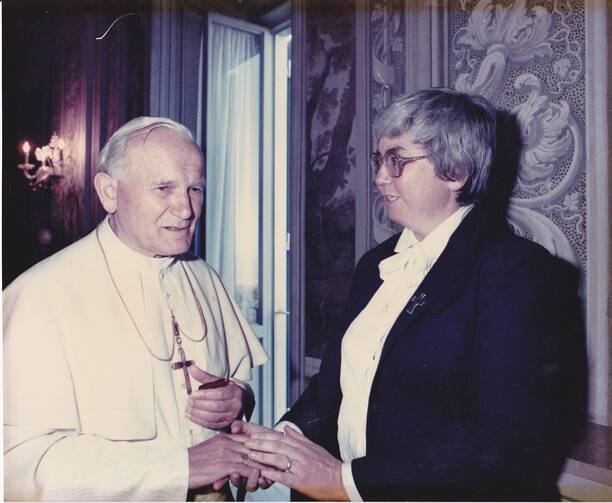A new series of profiles on the blog for the Sisters of Mercy offers a moving look at the lives of women who have spent decades embodying Mercy in their communities and in the church and who now, in the face of serious illness, find grace in accepting this mercy from others.
One of these powerful stories, written by Catherine Walsh, Northeast Communications Specialist for the Sisters of Mercy, is about our colleague and friend, Sister Mary Ann Walsh, who has been diagnosed with metastatic breast cancer. She faces her illness with the same grace, class, faith and fortitude with which she approached life:
After a nearly 30-year career as a journalist in Washington, D.C., and Rome, Sister Mary Ann Walsh, who is 67, has returned to the Sisters of Mercy’s convent in Albany, New York, to live out her final days with metastatic breast cancer. There her sisters lift her up daily in prayer and in practical ways.
They vie to push her wheelchair into the chapel for morning Mass and to the dining room, including a 90-year-old sister who says she was “certified” by the convent’s staff nurse for this duty. One sister brings Sister Mary Ann toast in the morning, when her appetite is weak. Others make her bed, do her laundry and help her with personal care.
“Mercy has jumped in from every corner to help me, in ways both large and small,” says Sister Mary Ann softly. “I want for nothing.” ...
Sister Mary Ann had been attracted to the Sisters of Mercy’s fourth vow of service as a high school student serving others through volunteer work with the Legion of Mary. Receiving Mercy instead of giving it “is very hard,” she says. “I feel undeserving. I don’t think I’ve ever been as good to people as they have been to me these past few months. But they assure me that I have!”
Her experience of cancer “is like a living wake,” continues Sister Mary Ann. “You get letters from people telling you all that you did and you had no idea. ‘You helped us with our marriage. You helped us with our adoption. My husband was sick with depression and you were there for us.’ And I wonder, ‘When did I do all that?’ It’s humbling.” Most profound of all, says Sister Mary Ann, has been the support of Sisters of Mercy in Albany and elsewhere. “Mercy sees your needs before you see them and it’s just been overwhelming,” she says. “It’s been a great embracing by the Mercy family.”
There's much more, so be sure to read the entire story (which brought me to tears), complete with photos and video, at the Sisters' blog.
Update: Those who would like to send cards of encouragement and prayer to Sister Mary Ann may do so at the following address.









Thanks for posting this, Kerry. Our readers can follow Sister Mary Ann's reporting for America here.